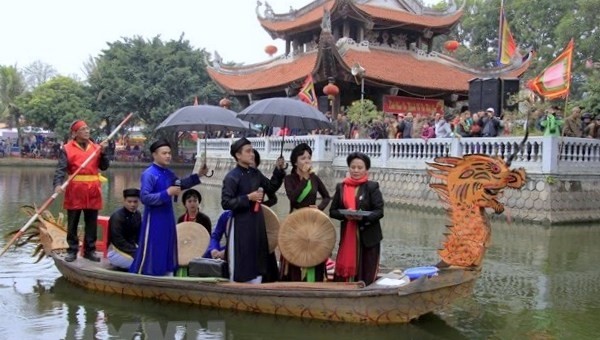That is why some researchers have stated that quan ho still exists but it is now gone. It sounds absurd but it is true because hat canh, the most interesting and quintessential part of quan ho, has virtually vanished. Hat canh is a form of quan ho in which a group of singers express their thoughts and feelings towards a twinned group of singers over a night.
Hat canh is the source of new quan ho songs when one side asks the other side to respond to their songs. It is a small contest between groups of quan ho singers. Today quan ho is mostly seen in the form of stage performance. In the past, hat canh was a private activity between quan ho groups without an audience.
But blame cannot be laid on the changes in how quan ho is performed. In the old days, a person’s living space was restricted to the boundary of their village and commune. One village was twinned with another village and one group of quan ho singers in that village was connected with another group in the other village. Quan ho singers not only met at festivals but also helped one another when they were in need. It was a strongly bonded relationship.
Human relationships in modern society are different. Even if the twinning relationship between two groups of quan ho singers still exists, it is not as strong as it used to be in the past. People nowadays are not confined to their village with ancient conventions. Hat canh, even when it is held in line with the traditional style, still lacks some kind of authentic human bond. Many visitors from afar who come to Bac Ninh are upset when treated to a quan ho performance with all kinds of speakers and amplifiers.
Talking about Bac Ninh where quan ho is considered a model in heritage conservation is to show that no matter how strong the preservation efforts are, heritages are certain to change.
Heritage preservation is always a hot topic at the start of a new lunar year. Almost everyone complains about how traditional festivals have been distorted and call for a return to the beauty of the good old days.
But with a deeper look at the root of the problem, it could be concluded that intangible heritages are what “live” along with changes in society. When society changes, intangible heritages will change accordingly.
In the past, the space of a festival was its village. The participants of a festival were mainly residents of that local community. There are only a few festivals with the participation of more than one village such as the Saint Giong Festival in Hanoi and the Lim Festival in Bac Ninh province. Today the space and participants of a festival have changed due to media coverage, greater wealth and changed social attitudes.
Today weird and unique festivals are good prey for the media to pounce on. When hyped up by the media, people will soon flock to such festivals. In the past, going to the famous Perfume Temple Festival on the outskirts of Hanoi was a lifetime dream but now people can attend the festival and go back in a single day. In the past visitors at a festival were, to some extent, a part of the festival because the rituals and other activities of that festival were associated with the gods worshipped by their community.
But now people go to a temple festival with a very different position. They go to festivals as visitors and outsiders more than as insiders.
At the Soc Temple Festival, the custom of competing for a basket of bamboo flowers took place within the local community. Today even outsiders want to vie for the sacred object. When tens of thousands of people from all corners flock to such a festival, a scramble is unavoidable. A similar situation is also present at several other festivals elsewhere in Vietnam.
It also demonstrates an absurdity when many call for traditional festivals to be returned to their own communities. But today the magnitude of many festivals has gone beyond the capacity of local organisers. Without the help of the authorities, security officers and new regulations, many festivals are bound to descend into chaos.
Researchers, regulators and ordinary people are blaming each other over how is best to preserve cultural heritage, especially festivals. For quan ho, many researchers have voiced their opposition when the art is no longer the same as its original form.
In fact, it is necessary to look at intangible heritages as living entities which are evolving along with societal changes. Conservation measures can work only when they are based on such changes. It is hopeless if we want heritages to stay the same as they were in the past.
 |
Local men scramble for a sacred object at a festival in northern Vietnam.
















